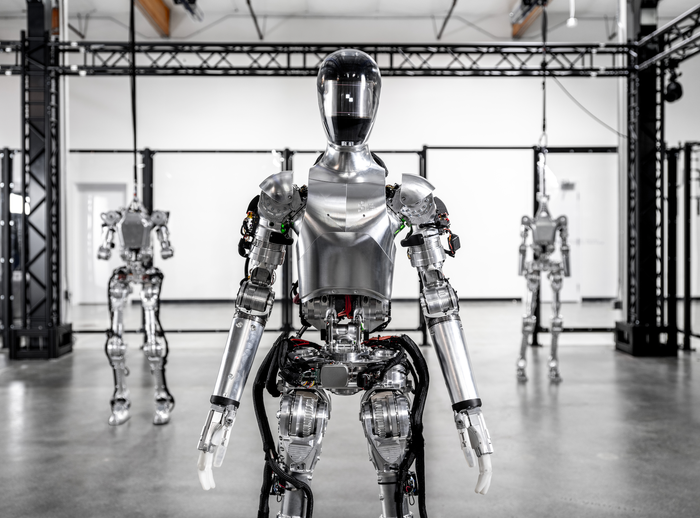Humanoid Robots From Figure AI: The Future Of UPS Delivery?

Table of Contents
Figure AI's Humanoid Robots: Capabilities and Limitations
Figure AI's humanoid robots represent a significant leap forward in robotics technology. However, understanding their capabilities and limitations is crucial to assessing their potential for UPS delivery.
Physical Capabilities
These robots boast impressive physical capabilities designed for efficient package handling.
- Dexterity: They possess the dexterity to pick up and handle a wide range of packages, from small envelopes to larger boxes, with precision and care. This dexterity extends to navigating obstacles and manipulating objects in complex environments.
- Strength and Load-Bearing Capacity: Figure AI's robots are designed to carry substantial weight, allowing them to manage multiple packages per delivery. Their strength ensures they can handle the physical demands of package transportation, even in challenging conditions.
- Mobility: Equipped with advanced locomotion systems, these robots can navigate various terrains, including stairs, uneven pavements, and other obstacles. This enhances their adaptability to diverse delivery locations. Their obstacle navigation capabilities are a crucial element of their functionality.
AI and Navigation
The AI powering Figure AI's humanoid robots is a cornerstone of their functionality.
- Autonomous Navigation: Using computer vision and SLAM (Simultaneous Localization and Mapping) technologies, these robots can autonomously navigate their surroundings, creating real-time maps and avoiding obstacles.
- Object Recognition: Advanced AI algorithms enable the robots to accurately identify and classify objects, including packages, obstacles, and even people. This ensures safe and efficient interaction with the environment.
- Route Optimization: The robots can analyze various routes and optimize their paths for speed and efficiency, adapting to real-time traffic and other unforeseen circumstances. This route optimization is key to minimizing delivery times.
Current Limitations
Despite their advanced capabilities, current humanoid robots face several limitations:
- Battery Life: Battery technology is still a limiting factor, restricting the operational range of the robots before they require recharging.
- Cost-Effectiveness: The high cost of development, manufacturing, and maintenance presents a significant hurdle to widespread adoption.
- Weather Resistance: Current models may struggle in extreme weather conditions, limiting their year-round functionality.
- Reliability and Potential for Malfunctions: Like any complex machine, the robots are susceptible to malfunctions, requiring robust maintenance and repair systems.
- Ethical Considerations: The deployment of humanoid robots raises ethical considerations concerning job displacement and potential safety concerns.
The Potential Impact on UPS Delivery Operations
The integration of Figure AI's humanoid robots into UPS's delivery network could have profound implications.
Efficiency and Cost Savings
- Delivery Speed: Automated delivery could potentially speed up delivery times, especially during peak seasons.
- Reduced Labor Costs: While initial investment is high, the robots could lead to significant long-term cost savings by reducing the need for human couriers.
- Increased Efficiency: Robots can operate 24/7, potentially increasing overall delivery efficiency and capacity. This operational efficiency could translate into substantial cost reductions.
Addressing Challenges in Last-Mile Delivery
Humanoid robots offer unique advantages in tackling the challenges of last-mile delivery:
- Traffic Congestion: Their ability to navigate sidewalks and pedestrian areas could bypass traffic congestion, improving delivery times.
- Difficult-to-Reach Locations: Their mobility allows them to access locations inaccessible to larger vehicles.
- Peak Demand: They can significantly increase delivery capacity during peak seasons, ensuring timely delivery even during periods of high demand. They offer a scalable solution to manage this peak demand.
Integration with Existing UPS Infrastructure
Integrating humanoid robots into UPS's current system presents significant logistical challenges:
- System Integration: Sophisticated software and infrastructure upgrades will be necessary to integrate the robots into existing tracking and routing systems.
- Infrastructure Upgrade: Existing infrastructure might need modifications to accommodate charging stations and robot maintenance facilities.
- Package Tracking and Security: Robust tracking systems are essential to monitor the robots' location and ensure the security of packages.
The Future of Humanoid Robots in Logistics and Beyond
The potential applications of humanoid robots extend far beyond UPS delivery.
Beyond UPS
- Other Logistics Companies: Many other delivery companies could benefit from implementing similar robotic systems.
- Warehouse Automation: Humanoid robots could revolutionize warehouse operations, automating tasks such as picking, packing, and transporting goods.
- Industrial Robotics: Their applications extend beyond logistics, potentially revolutionizing various industrial processes.
Technological Advancements
Future advancements in robotics and AI could dramatically enhance the capabilities of delivery robots:
- Improved Battery Technology: Longer-lasting batteries will extend operational range and reduce the frequency of recharging.
- Advanced AI Capabilities: More sophisticated AI algorithms will improve navigation, object recognition, and problem-solving skills.
- Enhanced Sensor Technology: Improved sensors will increase the robots' awareness of their environment and enhance their safety and efficiency.
Conclusion: The Humanoid Robot Revolution in UPS Delivery – A Glimpse into the Future
The potential of humanoid robots like those from Figure AI to revolutionize UPS delivery is undeniable. While challenges remain in areas like cost-effectiveness, battery life, and weather resistance, the advantages in terms of efficiency, cost savings, and the ability to overcome last-mile delivery challenges are significant. The future of logistics may well involve a collaborative effort between humans and robots, optimizing delivery operations and ushering in a new era of efficiency. To learn more about Figure AI's innovative humanoid robots and the future of automation in logistics, visit their website [Insert Link Here] and explore the exciting possibilities for UPS delivery and beyond.

Featured Posts
-
 Akhr Thdyth Trtyb Hdafy Aldwry Alinjlyzy Bed Hdf Haland Dd Twtnham
May 01, 2025
Akhr Thdyth Trtyb Hdafy Aldwry Alinjlyzy Bed Hdf Haland Dd Twtnham
May 01, 2025 -
 Key Highlights From Michael Jordans Basketball Career
May 01, 2025
Key Highlights From Michael Jordans Basketball Career
May 01, 2025 -
 Town Hall With Dr Victoria Watlington Moderated By Joe Bruno Channel 9
May 01, 2025
Town Hall With Dr Victoria Watlington Moderated By Joe Bruno Channel 9
May 01, 2025 -
 Thanh Tich Xuat Sac Cua Dh Ton Duc Thang Tai Giai Bong Da Sinh Vien Quoc Te 2025
May 01, 2025
Thanh Tich Xuat Sac Cua Dh Ton Duc Thang Tai Giai Bong Da Sinh Vien Quoc Te 2025
May 01, 2025 -
 Dragons Den Success Strategies Tips And Tricks From The Show
May 01, 2025
Dragons Den Success Strategies Tips And Tricks From The Show
May 01, 2025
Latest Posts
-
 Kawhi Leonard Leads Clippers To Victory Over Cavaliers
May 01, 2025
Kawhi Leonard Leads Clippers To Victory Over Cavaliers
May 01, 2025 -
 Cavs 10 Game Winning Streak Continues With Overtime Victory Against Blazers
May 01, 2025
Cavs 10 Game Winning Streak Continues With Overtime Victory Against Blazers
May 01, 2025 -
 Overtime Thriller Cavs Defeat Blazers 133 129 Hunter Scores 32
May 01, 2025
Overtime Thriller Cavs Defeat Blazers 133 129 Hunter Scores 32
May 01, 2025 -
 Kinopoisk Otmechaet Rekord Ovechkina Soski S Ego Ulybkoy Dlya Malyshey
May 01, 2025
Kinopoisk Otmechaet Rekord Ovechkina Soski S Ego Ulybkoy Dlya Malyshey
May 01, 2025 -
 Cleveland Cavaliers Defeat Portland Trail Blazers De Andre Hunters Impact On 10 Game Winning Streak
May 01, 2025
Cleveland Cavaliers Defeat Portland Trail Blazers De Andre Hunters Impact On 10 Game Winning Streak
May 01, 2025
